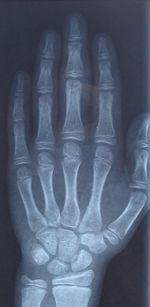Growth spurt
A growth spurt is a significant increase in the rate of growth (increase). The speed of growth is defined as the increase in body size (mass, volume, length, width) per time period.
Puberty growth spurt
As the body grows, the rate of growth usually increases after birth and then falls to a minimum in the infantile resting phase . In humans, for example, the increase in body height in early development is over 20 cm / year and then sinks to below 6 cm / a.
Only at puberty does the growth increase again. This puberty growth spurt is induced in mammals mainly by estrogens , which increase the secretion of growth hormone , IGF-1 and local growth factors . In male individuals, androgens also stimulate body growth during later puberty . The puberty growth spurt begins about two years earlier in girls than in boys, but is less pronounced. It lasts 2.8 years on average. In hypogonadism there is no growth spurt.
Growth spurts in early childhood development
During early childhood development, the supposed developmental leaps of newborns in around the first 14 months of life are called growth spurts . These "growth spurts" are explicitly not to be read in the physical, but in the mental development. The "relapses" would take place around the same time in newborns. The decisive factor is the time since the calculated due date, not the actual due date. The growth spurts would be accompanied by particularly severe discomfort in the infant. The criteria for this are vague and are not scientifically observed.
Orthodontics
In orthodontics (KFO), determining the start of the pubertal growth spurt is often crucial in determining the right time to start orthodontic therapy. Hand x-rays have proven to be a reliable tool for this. There are two common methods for this: The first is the so-called SMA system (Skeletal Maturity Assessment). It was developed by Fishman, based on the observation of six anatomical points located on the thumb, middle finger, pink and radius. In order to be able to assess the skeletal maturity of patients, Björk used maturity indicators that are typical for the age range between 9 and 16 years of interest from an orthodontic perspective. The ratio of dia- and epiphyses of the first, second and third phalanx, as well as the appearance of smaller bone structures, for example. of the sesamoid , are analyzed. There is also the Cervical Vertebral Maturation Method (CVM), with which the skeletal age is determined on the basis of X-rays of the cervical vertebrae and the shape of the cervical vertebrae.
Individual evidence
- ^ Ludwig von Bertalanffy : Growth. (= Handbook of Zoology. Volume 8: Mammalia . Lfg. 10, Part 4: Intraplasmic Metabolism. Article 6). Walter de Gruyter, 1957, ISBN 978-3-11-005435-4 .
- ^ A b Freimut Leidenberger, Thomas Strowitzki, Olaf Ortmann: Clinical endocrinology for gynecologists. Springer-Verlag, 2009, ISBN 978-3-540-89760-6 , p. 85.
- ↑ familie.de
- ↑ Hetty Van De Rijt, Frans X. Plooij, Regine Brams: Oh dear , I'm growing! Of the eight "leaps" in your child's mental development during the first 14 months. Mosaik-Verlag, 1994, ISBN 3-576-10415-1 .
- ↑ Gary Ezzo, Robert Bucknam: Babywise – Sleep well, my little darling: How your child will be completely satisfied and finally sleep through. adeo Verlag, 2014. Section "Understanding growth spurts"
- ↑ JR Bierich: Investigations into the genesis of the growth spurt. In: Monthly for Pediatrics. 129, 1981, pp. 393-399.
- ^ LS Fishman: Chronological versus skeletal age, an evaluation of craniofacial growth. In: The Angle orthodontist. Volume 49, Number 3, July 1979, pp. 181-189, doi : 10.1043 / 0003-3219 (1979) 049 <0181: CVSAAE> 2.0.CO; 2 , PMID 225970 .
- ↑ LS Fishman: Radiographic evaluation of skeletal maturation. A clinically oriented method based on hand-wrist films. In: The Angle orthodontist. Volume 52, Number 2, April 1982, pp. 88-112, doi : 10.1043 / 0003-3219 (1982) 052 <0088: REOSM> 2.0.CO; 2 , PMID 6980608 .
- ↑ Various methods of evaluating hand x-rays , dissertation. P. 14. Retrieved August 8, 2016.
- ^ A. Björk: Prediction of mandibular growth rotation. In: American journal of orthodontics. Vol. 55, Number 6, June 1969, pp. 585-599, PMID 5253957 .
- ↑ T. Baccetti, L. Franchi, JA McNamara: An improved version of the cervical vertebral maturation (CVM) method for the assessment of mandibular growth. In: The Angle orthodontist. Volume 72, number 4, August 2002, pp. 316-323, doi : 10.1043 / 0003-3219 (2002) 072 <0316: AIVOTC> 2.0.CO; 2 , PMID 12169031 .
